Social and economic development. Рубрика в журнале - Arctic and North
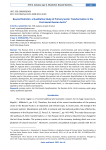
Статья научная
The Russian Arctic is at the epicentre of economic, environmental, and social changes. At the same time, the peripheral character of the territory, its strong orientation on primary sector makes the region extremely volatile to suchlike shifts. The study concerns primary sector transformation in the Post-Soviet period when after 1991 significant changes in the economy were observed. The main aim of the paper is to identify the specifics, features and development prospects of the recent primary sector transformation in the Russian Arctic. The statistical methods do not reflect the full picture of the transformation. Firstly, Russia has switched to UN national accounts system only in 1994. Secondly, the Arctic statistics after 2009 for regional level is unavailable. That is why the main method of the research is the expert survey method. The results of the study demonstrate the dominant role of the primary sector and the strong dependence of Russian Arctic regions on these activities. The study identifies the key factors and drivers of the transformation, a specific position of the oil and gas sector and the role of natural resources to be traditionally used in the primary sector. Despite the positive role of economic diversification in the long-term economic development, the corresponding effect for the Arctic regions is not fully expressed. The methodological novelty of the research is an unconventional research method of investigating primary sector transformation on the regional level in the Post-Soviet Russian Arctic, i.e. the expert survey. The method can be applied to other countries and industries.
Бесплатно

Business and government: environmental and economic responsibility in the Russian Arctic
Статья научная
The growing interest in environmental problems on the part of society leads to the fact that more and more attention is paid to the activities of enterprises, and the criteria for the greening of their production are becoming more stringent. With the growth of industrial production, the scale of the negative impact on the environment increases, so simply discussing environmental problems becomes insufficient. There is a need for a comprehensive accounting of the environmental performance of organizations and the development of measures to compensate for the resulting environmental damage. The article examines the issues of environmental and economic relations between business and government in the Russian Arctic. The purpose of this study is to form a theoretical approach to solving the problem of greening the Arctic regions based on the analysis of the ecological and economic relations between government and business. Legal and economic instruments for regulating environmental protection in Russia, as well as strategic documents for the development of the Russian Arctic in the field of ecology are analyzed. An assessment of the environmental and economic responsibility of companies operating in the Russian Arctic is carried out on the basis of non-financial reporting data. The results of the analysis show that the presented non-financial information is not transparent enough, and the level of business responsibility is rather low. To solve the problem posed, the authors propose a theoretical approach to building a "green" partnership, which allows finding a compromise between the interests of the state and business. The formation of an integrated ecological and economic approach in the state regulation of environmental protection activities will allow reaching a point of bifurcation in the relationship between government and business and thereby leveling the anthropogenic load on the ecosystem of the territory.
Бесплатно
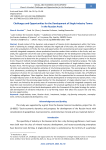
Challenges and Opportunities for the Development of Single-Industry Towns in the Russian Arctic
Статья научная
Broad context of the dynamics and prospects of Russian Arctic development within the framework of achieving its strategic objectives indicates the magnitude of the tasks, the solution of which consists in the actualization of, firstly, the risks and opportunities for environmental and social responsibility of vertically integrated companies, whose production branches conduct their activities in the Arctic, and, secondly, the supportive role of the state as the regulator of conditions for the development of business initiatives. The aims of the study are to identify significant factors that influence the dynamics of socio-economic development and to determine the prospects for the development of single-industry towns in the Russian Arctic. Research methods include bibliographical, comparative, economic and statistical analysis. The study substantiates the critical factors limiting the development opportunities of single-industry towns in the Russian Arctic. The first group is represented by the state of mineral resource base, which determines natural limits and cyclicality of production activities of city-forming enterprises. The second group is the global crisis phenomena, producing the dependence of production of city-forming enterprises on the external conjuncture of prices for raw materials and main export items. The third group includes risks of fulfilment of budgetary obligations. Taken together, these factors limit the opportunities for economic diversification of single-industry towns in the Russian Arctic and the development of entrepreneurial activity there. It has been revealed that the promising opportunities for the development of single-industry towns in the Russian Arctic are limited by the priority areas of investment activities of vertically integrated companies and imperfect state instruments of development support. The practical significance of the study is determined by the current trajectory of territorial development within the framework of the global strategy for sustainable development of extractive industries of a city-forming nature that takes into account not only risks, but also opportunities.
Бесплатно
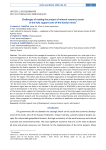
Статья научная
The article analyzes the managerial innovation of the Russian government on a new type of territorial management of the Arctic macroregion - support zones of development. The authors present an overview of the mineral deposits developed and planned for development within the boundaries of the Kola Peninsula and investment projects of the largest mining companies of the Murmansk region and, above all, the project “Kola Chemical and Technological Cluster” in accordance with the requirements developed by the federal regulator for forming mineral resource centers in support zones of development in the Arctic Particular attention is paid to the deposits of strategic and scarce minerals attractive for private investors. They will not require significant expenditures from regional authorities and local selfgovernments for development activities or any other methods of the state support and are socially significant for the region. The authors also discuss methodical approaches to management decisions when selecting the most efficient projects for implementing, the goals of socio-economic development and ensuring the ecological safety in the Arctic region under the global climate changes. Basing on the draft federal law “On the Arctic zone of the Russian Federation”, it was concluded that the mineral resource center of the Murmansk region was not likely to be included in the pilot project in 2018-2020 to form the Kola support zone of development in the Arctic. Proposals on harmonizing the requirements for registering applications of the Russian Arctic regions for forming the mineral resource center of the Kola support zone with the order on inclusion of mineral reserves in the state balance list. The authors justified methodology for developing investment projects and the procedures for their state comprehensive and environmental assessments. Some proposals for enhancing the efficiency of activities of applicants and participants in the support zone are made.
Бесплатно
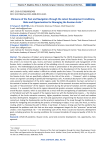
Статья научная
The uniqueness of today's social processes triggered by the COVID-19 pandemic determines the lack of insights into the transformation of the socio-economic space of the Russian Arctic. The purpose of this article is to review the past, recent, and future conditions for development and management of the Russian Arctic, considered in the context of the unfolding crisis of a non–economic nature and its consequences. The methodological peculiarity of the review is presentation of the phenomenon of the current crisis in the context of interrelated fundamental problems of the development of the Russian Arctic, the new economic reality, which makes it difficult to reliably predict the future. This naturally led to the substantiation of a series of contradictions and difficulties in implementing the declared development goals of the Russian Arctic, that are specifically reflected in the title of the article — "chimeras", which in biology means an organism consisting of genetically heterogeneous cells. A statistical description of the specifics of socio-economic development of the Arctic regions under the COVID-19 pandemic has been carried out in the context of review of the support measures, examination of the economic structure and the corresponding scale of "disconnection" of the regions' economies during the period of isolation and the subsequent recovery. It is revealed that the Arctic regions demonstrate greater economic resilience compared to the overall Russian situation, which is associated not so much with the strengthening of stabilization measures at the federal level with the support of the regional level, but with the fundamental reasons — the relative simplicity of the Arctic extractive economy, higher population incomes, low level of small and medium business development. Navigation on the risks and opportunities of governing the Russian Arctic has been carried out, linking the fundamentals and the practical implications of the study through the traditional rationale for navigating and considering the practice of managing an object, in our case, the Arctic, as well as routing, which is, choosing the path to follow. In particular, it makes a strong case that the pandemic has deepened the problems and risks that are also major management targets for the "precursor" period and creates a new hypothetical risk — the diminishing scale of the Arctic's social and economic development goals, including practices for securing conditions for increased standards of living and quality of life for its people.
Бесплатно
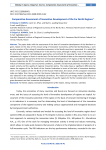
Comparative assessment of innovative development of the Far North regions
Статья научная
The paper deals with the assessment of the level of innovative development of the Northern regions. Based on the data of the annual rating of innovative economies, performed by Bloomberg, a comparative analysis of the rating of innovative economies in the Nordic countries is presented. It is noted that Russia has been consistently ranked 25-27 in the last four years, although in 2016, it was in the 12th place. An overview analysis of methodological approaches and methods for assessing the level of innovative development of a region in Russia is carried out. On the basis of statistical data on the composite integral index, a comparative assessment of the level of innovative development of 17 regions of the Far North of the Russian Federation for 2017 is carried out, and the corresponding ranks are analyzed separately for 5 sub-indices of thematic blocks: socio-economic conditions, scientific and technical potential, innovation activity, export activity and the quality of regional innovation policy. The study shows a significant difference between the regions of the Far North of the Russian Federation in terms of the level of innovative development. In five subjects of the Far North of the Russian Federation, the values of the composite innovation index are higher than the average for the Russian Federation. Different positions occupied by regions are also observed in the rankings for individual sub-indices. The results of such ratings make it possible to assess the comparative advantages and disadvantages of specific regions for further consideration in the program documents on their innovative development.
Бесплатно
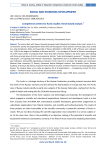
Competence centers for Arctic studies: thesis-based analysis
Статья научная
The article deals with theses thematic grouping, both following the Russian Arctic zone’s areas of socio-economic activity and organizations where they were prepared. Thesis selection on Arctic topics was carried out using morphemes (titles and keywords) of theses defended in 1990-2018. 1.436 of theses were selected, incl. 1.201 for the degree of Candidate of Sciences and 235 - for the degree of Doctor of Sciences amounting to 1% of the total number of analyzed theses. More than 50% of theses related to the Arctic topics were dealing with three principal areas of Arctic socio-economic activity: “water and biological resources”, “ecology, climate and people”, and “geology and minerals”. Researchers’ organizations were located in 51 different territories of the Russian Federation. Among 503 organizations involved in Arctic research on all topics, the leaders are Lomonosov Moscow State University (72 theses), Murmansk Marine Biological Institute, Kola Scientific Center, Russian Academy of Sciences (62 theses), Knipovich Polar Research Institute of Marine Fisheries and Oceanography (43 theses). The analysis allows us to create an objective list of all organizations - Competence centers for Arctic studies - involved in areas related to Arctic socio-economic activity.
Бесплатно
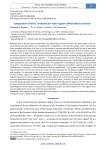
Composition of Arctic Territories for State Support: Which Way to Choose?
Статья научная
Due to the fact that currently there are several lists of Arctic territories for state support, the article describes possible options for changing their composition in the forecast period of the next decade: from complete unification of all lists to, on the contrary, extreme diversification (each list has its own tasks of state support). The research question of the article is to determine the benefits and costs of each scenario for the “set” of Arctic territories for government support. Main results: 1) four scenarios of evolution of the current system of state support of the Arctic and northern territories according to the geographical factor (composition of territories for support) — a) optimal-administrative; b) anti- district; c) polyphonic; d) limited diversity; 2) radical anti-district and optimal-administrative scenarios, comfortable for federal executive authorities, carry the highest integral risks. The polyphonic “evolutionary” scenario carries minimal risks, when, simultaneously with the preservation of the institution of northern regional guarantees and compensation, institutions of the multifaceted Arctic are established — for resident investors, geostrategic, and entrepreneurial. But it also turns out to be the most expensive for the federal budget; 3) for the integral scenario, it is advisable to take into account the following elements of the described scenarios: multiple lists of Arctic regions for different forms of state support; preservation in a limited form of the former regional institution of social support for the northern and Arctic territories; full support for small and medium-sized manufacturing entrepreneurs in the Arctic and North, primarily in areas with limited delivery times for goods; gradual transformation of support for localities equated to regions of the Far North, from northern and Arctic institutions to all-Russian regional ones; introduction of institutions that encourage the technological transformation of the previous industrial structure and the formation of a new digital structure throughout the Arctic zone of the Russian Federation.
Бесплатно
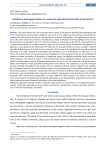
Conditions and opportunities to realize the agricultural potential of the North
Статья научная
The article shows the role of the agricultural sector of the North in providing the population with fresh food products, preserving the traditional way of life of the indigenous ethnic groups, sustainable de-velopment of the northern territories, and ensuring the country's food security. The organization of agriculture in the north and Arctic territories of Scandinavia, Canada and Alaska and the possibility of its use in the Russian North, considering its own rich historical experience, is discussed in the article. The generalization of agricultural practices in northern countries allows us to recommend the Scandinavian development of agriculture and, above all, the experience of Finland for the European North of Russia. Canadian model of agricultural development is of little use for the Russian North since it was designed for sparsely populated territories. The study revealed the possibilities and limitations of the development of agriculture in the North. The critical points for the socio-economic development in the agrarian sector are the availability of natural and labor resources, the possibility of organizing organic (ecological) production within the traditional industries, the industrial nature of the economy that directs significant financial resources for the industrial modernization and the integrated development of rural areas. The study also revealed the possibilities and limitations of the agricultural development of the North. The constraints of agricultural development and food self-sufficiency are explicit. They are related to extreme natural conditions, low availability of biological resources, the poor technical support of the agrarian sector, low-qualified employees and hard living conditions of peasants, unfavorable external environment, inefficient state support, unavailability of loans, and unsustainable sales of agricultural products. The changes in the agriculture of the northern territories after the All-Russian Agricultural Censuses 2006 and 2016 revealed. The results of the study serve the ground for substantiating conceptual approaches to the development of agricultural production and increasing the level of food self-sufficiency of the local population.
Бесплатно
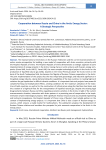
Cooperation between Russia and China in the Arctic Energy Sector: A Strategic Perspective
Статья научная
The imposed sectoral restrictions on the Russian Federation and the current macroeconomic situation create prerequisites for building a new model of cooperation with Asian countries, primarily with the People’s Republic of China. The People’s Republic of China demonstrates a strategic approach to joint implementation of energy projects in the Arctic, having shares in joint ventures with Russian energy companies (Yamal LNG, Arctic LNG-2). Yamal LNG, the most complex technological project in the Arctic for the production of liquefied natural gas (LNG), located on the Yamal Peninsula above the Arctic Circle on the basis of the South Tambeyskoe field, has become the flagship of Russian-Chinese cooperation in the Arctic. The joint implementation of this project has the most important geostrategic and industrial significance in the global energy industry, clearly demonstrating the capabilities of the two countries in creating high-tech solutions for gas liquefaction in difficult climatic conditions. It is important that such projects have powerful complex-forming and multiplicative effects, creating conditions for the maximum utilisation of the industries of both countries, as well as for the construction of infrastructure along the Northern Sea Route and the creation of a high-tech fleet for the transportation of liquefied natural gas. Despite the existing legal disagreements between Russia and China regarding economic activities in the Arctic, in light of the current macroeconomic situation, interaction with Asian partners is a promising area of cooperation in the implementation of joint technological projects. With significant financial resources and accumulated engineering and technical competences, the People’s Republic of China is one of Russia's most reliable partners in the context of implementing energy projects. It is important that China is also a buyer of Russian energy resources, which ensures a stable market for hydrocarbons. The publication analyses the development of Russian-Chinese relations and considers the prospects for joint economic cooperation in the Arctic in the energy sector.
Бесплатно
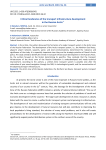
Critical tendencies of the transport infrastructure development in the Russian Arctic
Статья научная
In the article, the authors discussed the formation of a single transport system in the Arctic zone of the Russian Federation. The development of the Arctic transport system, i.e., the Northern Sea Route, adjacent airport network, seaports, water, and land communications, determined the relevance and significance of the study. It is especially important since they are the strategic priorities of Russia's Arctic policy. The study aimed to identify the trends in transport infrastructure development in the Russian Arctic. So, the authors focused on the factors determining its specifics. They conclude that the transport infrastructure of the Arctic zone of the Russian Federation is underdeveloped and needs technical improvement. According to the authors, a unified Arctic transport system is possible only after the restoration of year-round navigation through the NSR, its technological growth, and the reconstruction of the adjoining transport infrastructure.
Бесплатно
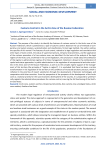
Customs Control in the Arctic Zone of the Russian Federation
Статья научная
The purpose of the study is to identify the features of customs control in the Arctic zone of the Russian Federation, which is positioned as a type of customs control. Based on the use of methods of comparative and system analysis, systematization and classification, formal legal method, the author outlines the specifics of this control. Five features of such control, related to its legal regulation and correlation with other types of state control, the status of supervised persons, temporal characteristics, and the application of the customs procedure of a free customs zone, are identified. On the basis of the analysis of the legal regime of the Arctic zone, enshrined in the current legislation, the conclusion is made about the attribution of this regime to administrative regimes of territory management. Attention is drawn to the combination of spatial and status approaches in public administration in the regulation of entrepreneurial and other activities in the Arctic zone of the Russian Federation, as well as to the complex regime support of the management of this territory (the principle of “regime in regime”). It is concluded that there has been a certain transformation in the regulation of the territory in the conditions of increased sanctions pressure, which is reflected in the priorities of import substitution through the development of domestic technologies and cooperation with Asian countries. From the perspective of the prospects of the development of the Arctic zone as a national priority for the socio-economic development of the country, it is proposed to systematically regulate the administrative procedures for customs control, ensuring the full functioning of the Northern Sea Route.
Бесплатно
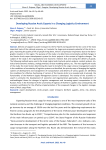
Developing Russian Arctic Exports in a Changing Logistics Environment
Статья научная
Delivery of cargoes by water transport to the Far North and equated territories is one of the most important tasks of the national economy, as it unlocks the huge socio-economic potential of the Arctic region, improving the quality of life of people living there, which is of particular importance due to the demographic situation in the region. The purpose of the study is to determine economically justified changes in the Russian Arctic export development system for Arctic projects in the context of logistics changes. The subject of the study is the organizational and economic relations that arise during the delivery of goods. The following methods were used in the study: logical and structural-system analysis, content analysis, statistical and economic analytics, analogy method, various modeling options, etc. The most significant results of the study: the main factors determining the need to transform the cargo turnover management system in the conditions of uncertainty of logistics systems are identified, the priority ways of changing the logistics systems of development and management of transportation and delivery of various goods are identified, the conditions for effective functioning of carriers of the Russian Arctic are revealed and structured, the functionality of the Northern Supply Management Center is developed. The novelty of the scientific research is primarily the development of economic and organizational approaches, the development of methodological theses for changes in logistics management and increasing export transportation in the Russian Arctic in the framework of the uncertainty of logistics of Northern supplies and, consequently, the economic justification for the effective implementation of the proposed changes in the logistics management of Arctic cargo flows.
Бесплатно
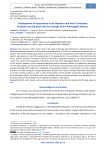
Статья научная
The relevance of this study is due to the need to develop and implement in regional practice effective management decisions that promote the development of fish farms and increase aquaculture production. Since fish farming (aquaculture) is one of the structural components of the fishery complex, the authors pay attention to both the peculiarities of its development in the conditions of the North and the Arctic, and the specifics of economic activity in the field of aquaculture projects. The article presents the results of a survey of the population of the Arctic territories of the Arkhangelsk Oblast on the consumption of fish and fish products, which allowed establishing various consumer profiles of preferences depending on their age category, as well as to identify the main reasons constraining the consumption of fish and fish products (among which: high price, availability of low-quality products in retail outlets, the lack of ability and desire to cook among the younger generation). Based on the results of expert interviews with producers of fish and fish products, as well as with representatives of the scientific community and authorities of the Arkhangelsk Oblast, a problem matrix was compiled and the necessary activities were identified to address key issues of the development of aquaculture projects in the region.
Бесплатно
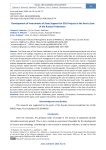
Статья научная
The Arctic zone of the Russian Federation is one of the key and promising territorial units of our country, which is of strategic importance not only for the national socio-economic system, but also for the world economy as a whole. For this reason, regional and federal authorities are continuously working on the issues of improving the efficiency of management of socio-economic development of this territory. One of the urgent directions is socio-ecological-economic development of the Arctic zone, which is impossible without appropriate support of public authorities and involvement of business structures and population in these processes. Special attention should be paid to the issues of resource support, including the stimulation of investment processes, in order to implement the ESG-agenda. The purpose of this study is to formulate scientific and practical recommendations for the development of the system of state support for ESG-projects, which are the driver of investment and environmental climate formation in the Arctic zone of the Russian Federation. The study proposes a toolkit of state support for ESG-projects, in which the key role is given to tax preferences for investors, as well as subsidizing the costs of residents at the expense of the regional and federal budgets and preferential conditions for attracting borrowed funds. The application of the proposed tools will not only allow business structures investing in the implementation of projects of socio-ecological-economic orientation in the Arctic zone to receive additional benefits, but will also become an incentive to reach full project capacity, which will achieve a synergistic effect in the form of profit for business entities and socio-economic effect for the authorities and the population in the form of new jobs, developed infrastructure and revenue to budgets at various levels.
Бесплатно
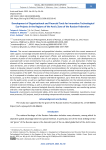
Статья научная
The current macroeconomic and geopolitical situation, combined with the current measures of state support, increasingly stimulate domestic business structures to implement new investment initiatives, which are designed, according to government officials and parliamentarians, to improve the socio-economic situation of the localization sites of such projects. In practice, however, such developments are associated with certain environmental risks such as pollution of water, air, soil, destruction of other key elements of the environment. Such negative impacts are particularly devastating for unique ecologically clean territories, one of which is the Russian part of the global Arctic zone. In this regard, the aim of this study is to develop relevant scientific and practical recommendations for activating and scaling up the investment activity of business structures implementing environmentally-oriented investment projects within the boundaries of the AZRF. The essence of these innovations is based on a combined approach. In particular, it is proposed to introduce up to seven new direct measures of financial incentives for eco-investments by businesses, up to five changes to regional and federal legislation, up to three direct financial injections into the public sector, as well as a significant adjustment of tax legislation into the national economy. From a practical point of view, this will create new preferential conditions for business and stimulate eco-oriented investment thinking, as well as eliminate accumulated environmental damage, restore and rehabilitate most natural sites, preserve biological diversity, develop a comprehensive eco-monitoring system, and take a new significant step towards creating a renewable resource economy.
Бесплатно
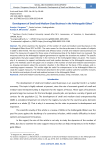
Development of Small and Medium-Sized Business in the Arkhangelsk Oblast
Статья научная
The article examines the dynamics of the number of small and medium-sized businesses in the Arkhangelsk Oblast from 2017 to 2021. The main reason for the sharp decrease in the number of subjects in 2020 is determined. The most vulnerable and affected areas of small and medium-sized businesses are listed. The measures of support for these areas of entrepreneurship at the federal level are reviewed. The measures taken by the Arkhangelsk regional government to regulate the situation are studied. The specific organizations that give support directly in the territory of the Arkhangelsk Oblast are given. The reasons why it is necessary to support and develop small and medium business in the Arkhangelsk economy are given. The methods used in this paper are an analysis of the number of small and medium-sized enterprises, drawing conclusions about the economic situation in the Oblast on the basis of this analysis, and researching support measures. This article might be useful for entrepreneurs in the Arkhangelsk Oblast to study the support measures. The information described in the article could be useful for scientific research, for statistics and analysis of small and medium business in the Arkhangelsk Oblast.
Бесплатно
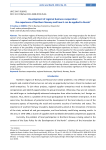
Статья научная
The northern regions of Norway and Russia have similar issues: new mega-projects for the development of oil and gas fields and infrastructure are not only an opportunity but also a challenge for the de-velopment of regional small and medium-size enterprises. To connect to projects, regional enterprises need to increase their competencies and find opportunities for cooperation with each other. The article presents the results of a study of the formation of a regional business alliance in Northern Norway. Further, it offers an analysis of the possibility of applying the North Norwegian experience to Russia. It is concluded that, although from a theoretical point of view, this is difficult, the prerequisites for the successful application of the studied experience exist in the Arkhangelsk Oblast and the Murmansk Oblast. Two business associations are successfully operating there. They were built considering the Norwegian experience, but with the active participation of local industry and authorities, as well as accounting regional specifics, values, and traditions. It is a powerful foundation for the further development of business cooperation. The article contains several recommendations for such forms of collaboration. It is proposed to pay attention to the following: qualification of the coordinator, public-private financing scheme, openness and integration of the project, primary importance of technological cooperation idea and secondary significance of the legal form to be chosen.
Бесплатно
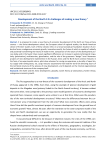
Development of the North 2.0: challenges of making a new theory
Статья научная
It is proposed to create a new theory of economic development of the North on three primary sources — the Soviet development school, the European school of regional studies, the North American school of frontier studies. Each of these schools relies on a broad conceptual foundation (location of productive forces, endogenous economic growth, innovative search), the fusion of which is capable of radically and positively transforming the theory of modern time. Comparison of the nature of the development process today and in the Soviet times reveals significant differences: an increase in spatial and temporal irregularity (polarization), multiactorism, glocalization, and the role of the grassroots “design” level. Numerous projects of new development implemented in the Russian Arctic and the North have common features in the form of an experimental nature, pilot-clone schemes for saving on experience, a plurality of equal status supply and training bases, etc. Large resource corporations that lead the world are directing actors of the territorial structure of the process of new development, and it depends on the internal organizational and institutional structure of the company itself.
Бесплатно
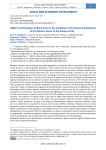
Статья научная
Complex natural-climatic and spatial-geographical conditions, which comprehensively characterize the Arctic as a zone of absolute discomfort, create systemic barriers to the introduction of digital technologies necessary for levelling the risks of population preservation. Of particular strategic importance for the Arctic zone of the Russian Federation are rural territories that provide a presence in the vast and sparsely populated space of the Russian Arctic, including in the areas of exploitation of key deposits of mineral and biological resources. The aim of the article is to analyze the directions of digital transformation of regional development that promotes innovative development of rural territories in the Western sector of the Russian Arctic (on the example of the Arkhangelsk Oblast and the Nenets Autonomous Okrug). Along with comparative analysis of scientific publications and content analysis of normative legal documents, a systematic review of strategic planning documents and indicators assessing the level of digitalization of the Arkhangelsk Oblast and the Nenets Autonomous Okrug with a special focus on the quality of life of the population was carried out. The analysis showed that digitalization processes react sensitively to the political and socio-economic situation, primarily the COVID-19 pandemic, economic recession and sanctions restrictions. The priorities of regional policy in the field of digital transformation have been identified, and insufficient attention to rural areas in this matter has been revealed. Under the concept of regional development “center-periphery”, the gap in the degree of development of digital ecosystems between urban and rural settlements is expected to increase, but the lack of official statistical indicators does not allow assessing its depth. Promising areas of state policy in the digital economy include systematic formation of digital competencies of the population, since digital literacy is the most important prerequisite for obtaining significant socio-economic effects of digitalization, as well as increasing the level of technical equipment of organizations, including through the expansion of subsidy programs for purchase of technical equipment used to provide goods, works and services of a socially oriented nature for the population.
Бесплатно

